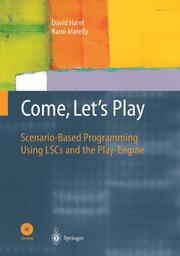Detailansicht
Come, Lets Play
Scenario-Based Programming Using LSCs and the Play-Engine
ISBN/EAN: 9783642624162
Umbreit-Nr.: 4537043
Sprache:
Englisch
Umfang: xviii, 382 S., 297 farbige Illustr.
Format in cm:
Einband:
kartoniertes Buch
Erschienen am 05.11.2012
Auflage: 1/2003
€ 53,49
(inklusive MwSt.)
Nachfragen
